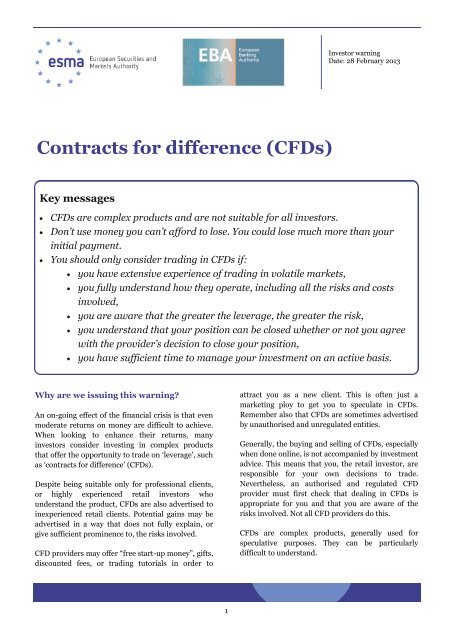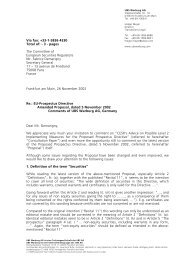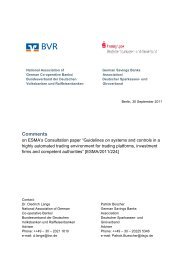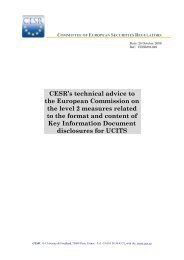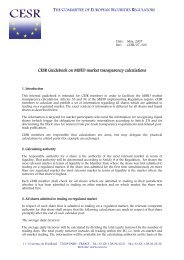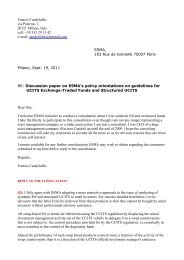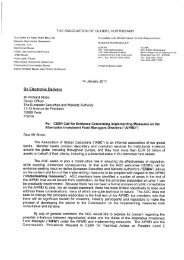Contracts for difference (CFDs) - Esma - Europa
Contracts for difference (CFDs) - Esma - Europa
Contracts for difference (CFDs) - Esma - Europa
Create successful ePaper yourself
Turn your PDF publications into a flip-book with our unique Google optimized e-Paper software.
Investor warning<br />
Date: 28 February 2013<br />
<strong>Contracts</strong> <strong>for</strong> <strong>difference</strong> (<strong>CFDs</strong>)<br />
Key messages<br />
<br />
<br />
<br />
<strong>CFDs</strong> are complex products and are not suitable <strong>for</strong> all investors.<br />
Don’t use money you can’t af<strong>for</strong>d to lose. You could lose much more than your<br />
initial payment.<br />
You should only consider trading in <strong>CFDs</strong> if:<br />
you have extensive experience of trading in volatile markets,<br />
you fully understand how they operate, including all the risks and costs<br />
involved,<br />
you are aware that the greater the leverage, the greater the risk,<br />
you understand that your position can be closed whether or not you agree<br />
with the provider’s decision to close your position,<br />
you have sufficient time to manage your investment on an active basis.<br />
Why are we issuing this warning?<br />
An on-going effect of the financial crisis is that even<br />
moderate returns on money are difficult to achieve.<br />
When looking to enhance their returns, many<br />
investors consider investing in complex products<br />
that offer the opportunity to trade on ‘leverage’, such<br />
as ‘contracts <strong>for</strong> <strong>difference</strong>’ (<strong>CFDs</strong>).<br />
Despite being suitable only <strong>for</strong> professional clients,<br />
or highly experienced retail investors who<br />
understand the product, <strong>CFDs</strong> are also advertised to<br />
inexperienced retail clients. Potential gains may be<br />
advertised in a way that does not fully explain, or<br />
give sufficient prominence to, the risks involved.<br />
CFD providers may offer “free start-up money”, gifts,<br />
discounted fees, or trading tutorials in order to<br />
attract you as a new client. This is often just a<br />
marketing ploy to get you to speculate in <strong>CFDs</strong>.<br />
Remember also that <strong>CFDs</strong> are sometimes advertised<br />
by unauthorised and unregulated entities.<br />
Generally, the buying and selling of <strong>CFDs</strong>, especially<br />
when done online, is not accompanied by investment<br />
advice. This means that you, the retail investor, are<br />
responsible <strong>for</strong> your own decisions to trade.<br />
Nevertheless, an authorised and regulated CFD<br />
provider must first check that dealing in <strong>CFDs</strong> is<br />
appropriate <strong>for</strong> you and that you are aware of the<br />
risks involved. Not all CFD providers do this.<br />
<strong>CFDs</strong> are complex products, generally used <strong>for</strong><br />
speculative purposes. They can be particularly<br />
difficult to understand.<br />
1
What is a CFD?<br />
A CFD is an agreement between a ‘buyer’ and a<br />
‘seller’ to exchange the <strong>difference</strong> between the current<br />
price of an underlying asset (shares, currencies,<br />
commodities, indices, etc.) and its price when the<br />
contract is closed.<br />
<strong>CFDs</strong> are leveraged products. They offer exposure to<br />
the markets while requiring you to only put down a<br />
small margin (‘deposit’) of the total value of the<br />
trade. They allow investors to take advantage of<br />
prices moving up (by taking ‘long positions’) or prices<br />
moving down (by taking ‘short positions’) on underlying<br />
assets.<br />
When the contract is closed you will receive or pay<br />
the <strong>difference</strong> between the closing value and the<br />
opening value of the CFD and/or the underlying<br />
asset(s). If the <strong>difference</strong> is positive, the CFD provider<br />
pays you. If the <strong>difference</strong> is negative, you<br />
must pay the CFD provider.<br />
<strong>CFDs</strong> might seem similar to mainstream investments<br />
such as shares, but they are very different as<br />
you never actually buy or own the asset underlying<br />
the CFD.<br />
Example of how a CFD works<br />
You believe a listed share (Share A) is undervalued<br />
and that its price will rise. You decide to buy 4000<br />
<strong>CFDs</strong> in Share A at the price of 10€ per CFD. Your<br />
‘position’ is there<strong>for</strong>e 40000€ (4000 x 10€). You do<br />
not actually pay 40000€: the amount you pay depends<br />
on the margin required by the CFD provider.<br />
If the CFD provider asks you <strong>for</strong> a margin of 5%, <strong>for</strong><br />
example, that means your minimum initial payment<br />
is 2000€ (40000€ x 5%). The return you get on this<br />
initial payment depends on the price at which Share<br />
A is traded when you decide to close your position<br />
(that is, when you sell the CFD).<br />
Share A<br />
price<br />
If the price of Share A decreases by 5% (from 10€ to<br />
9.5€), and the leverage is 20, you lose the total<br />
amount (-100%) of your initial margin payment, i.e.<br />
you lose 2000€. If the price of Share A decreases by<br />
10% (from 10€ to 9€), and the leverage is 20, you<br />
lose your initial payment of 2000€, and your CFD<br />
provider will ask you <strong>for</strong> another 2000€ (margin<br />
call) if you want to keep your contract open.<br />
This means that your losses may be more than your<br />
initial margin payment.<br />
Costs<br />
Share A<br />
return<br />
Profit/loss<br />
<strong>for</strong> investor<br />
Return <strong>for</strong><br />
investor<br />
7.5€ -25% -10000€ -500%<br />
9.0€ -10% -4000€ -200%<br />
9.5€ -5% -2000€ -100%<br />
9.9€ -1% -400€ -20%<br />
10.0€ 0% 0€ 0%<br />
10.1€ 1% 400€ 20%<br />
10.5€ 5% 2000€ 100%<br />
In addition to any profits or losses, there are different<br />
types of costs linked to transactions in <strong>CFDs</strong>.<br />
Costs will impact the effective return. Examples of<br />
costs include commissions charged by CFD providers.<br />
Be aware that while some CFD providers charge<br />
a general commission, others charge a commission<br />
on each trade (i.e. on opening and closing a contract).<br />
Costs related to CFD trading may also include bidoffer<br />
spreads, daily and overnight financing costs,<br />
account management fees, and taxes (depending on<br />
the jurisdiction in which you and the CFD provider<br />
operate). These costs can be complex to calculate<br />
and may outweigh the gross profits from a trade.<br />
2
What are the main risks of investing in<br />
<strong>CFDs</strong>?<br />
<strong>CFDs</strong>, especially when highly leveraged (the higher<br />
the leverage of the CFD, the more risky it becomes),<br />
carry a very high level of risk. They are not standardised<br />
products. Different CFD providers have<br />
their own terms, conditions and costs. There<strong>for</strong>e,<br />
generally, they are not suitable <strong>for</strong> most retail investors.<br />
You should only consider trading in <strong>CFDs</strong> if you<br />
wish to speculate, especially on a very short-term<br />
basis, or if you wish to hedge against an exposure in<br />
your existing portfolio, and if you have extensive<br />
experience in trading, in particular during volatile<br />
markets, and can af<strong>for</strong>d any losses.<br />
Time is not on your side<br />
<strong>CFDs</strong> are not suitable <strong>for</strong> ‘buy and hold’ trading.<br />
They can require constant monitoring over a short<br />
period of time (minutes/hours/days). Even maintaining<br />
your investment overnight exposes you to<br />
greater risk and additional cost.<br />
The volatility of the stock market and other financial<br />
markets, together with the extra leverage on<br />
your investment, can result in rapid changes to your<br />
overall investment position. Immediate action may<br />
be required to manage your risk exposure, or to post<br />
additional margin.<br />
There<strong>for</strong>e, if you do not have enough time to monitor<br />
your investment on a regular basis, you should<br />
not trade in <strong>CFDs</strong>.<br />
In addition, the margin you need to maintain as a<br />
deposit with the CFD provider is recalculated daily<br />
in accordance with changes in the value of the underlying<br />
assets of the <strong>CFDs</strong> you hold. If this recalculation<br />
(revaluation) produces a reduction in value<br />
compared with the valuation on the previous day,<br />
you will be required to pay cash to the CFD provider<br />
immediately in order to restore the margin position<br />
and to cover the loss. If you cannot make the payment,<br />
then the CFD provider may close your position<br />
whether or not you agree with this action. You<br />
will have to meet the loss, even if the price of the<br />
underlying asset subsequently recovers. There are<br />
CFD providers that liquidate all your CFD positions<br />
if you do not have the required margin, even if one<br />
of those positions is showing a profit <strong>for</strong> you at that<br />
stage.<br />
To keep your position open, you may have to agree<br />
to allow the CFD provider to take additional payments<br />
(usually from your credit card), at their discretion,<br />
when required to meet relevant margin<br />
calls. In a fast moving, volatile market you can easily<br />
run up a large credit card bill in this way.<br />
Leverage risk<br />
Leveraged trading means that potential profits are<br />
magnified; it also means that losses are magnified.<br />
The lower the margin requirement, the higher the<br />
risk of potential losses if the market moves against<br />
you. Sometimes the margins required can be as little<br />
as 0.5%. Be aware that when trading using margin,<br />
your losses can exceed your initial payment and it is<br />
possible to lose much more money than you initially<br />
invested.<br />
Liquidity risk<br />
Liquidity risk affects your ability to trade. It is the<br />
risk that your CFD or asset cannot be traded at the<br />
time you want to trade (to prevent a loss, or to make<br />
a profit).<br />
3
‘Stop loss’ limits<br />
To limit losses many CFD providers offer you the<br />
opportunity to choose ‘stop loss’ limits. This automatically<br />
closes your position when it reaches a<br />
price limit of your choice. There are some circumstances<br />
in which a ‘stop loss’ limit is ineffective - <strong>for</strong><br />
example, where there are rapid price movements, or<br />
market closure. Stop loss limits cannot always protect<br />
you from losses.<br />
Execution risk<br />
Execution risk is associated with the fact that trades<br />
may not take place immediately. For example, there<br />
might be a time lag between the moment you place<br />
your order and the moment it is executed. In this<br />
period, the market might have moved against you.<br />
That is, your order is not executed at the price you<br />
expected.<br />
What can you do to protect yourself?<br />
You should carefully read your agreement or contract<br />
with the CFD provider be<strong>for</strong>e making a trading<br />
decision.<br />
You should make sure that you at least understand<br />
the following:<br />
<br />
<br />
<br />
<br />
the costs of trading <strong>CFDs</strong> with the CFD provider,<br />
whether the CFD provider will disclose the margins<br />
it makes on your trades,<br />
how the prices of the <strong>CFDs</strong> are determined by<br />
the CFD provider,<br />
what happens if you hold your position open<br />
overnight,<br />
Some CFD providers allow you to trade even when<br />
the market is closed. Be aware that the prices <strong>for</strong><br />
these trades can differ widely from the closing price<br />
of the underlying asset. In many cases, the spread<br />
can be wider than it is when the market is open.<br />
<br />
<br />
whether the CFD provider can change or requote<br />
the price once you place an order,<br />
whether the CFD provider will execute your<br />
orders even if the underlying market is closed,<br />
Counterparty risk<br />
Counterparty risk is the risk that the provider issuing<br />
the CFD (i.e. your counterparty) defaults and is<br />
unable to meet its financial obligations. If your<br />
funds are not properly segregated from the CFD<br />
provider’s funds, and the CFD provider faces financial<br />
difficulties, then there is a risk that you may not<br />
receive back any monies due to you.<br />
<br />
whether there is an investor or deposit protection<br />
scheme in place in the event of counterparty<br />
or client asset issues.<br />
If you do not understand what’s on offer, do not<br />
trade.<br />
Further in<strong>for</strong>mation<br />
Always check if the CFD provider is authorised to do investment business in your country. You can check this on<br />
the website of the CFD provider’s national regulator.<br />
A list of all the national regulatory authorities, and their websites, is also available on the:<br />
<br />
<br />
ESMA website at http://www.esma.europa.eu/investor-corner<br />
EBA website at http://www.eba.europa.eu/Publications/Consumer-Protection-Issues.aspx<br />
4


